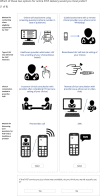Assessing preferences for HIV pre-exposure prophylaxis (PrEP) delivery services via online pharmacies in Kenya: protocol for a discrete choice experiment
- PMID: 37012008
- PMCID: PMC10083853
- DOI: 10.1136/bmjopen-2022-069195
Assessing preferences for HIV pre-exposure prophylaxis (PrEP) delivery services via online pharmacies in Kenya: protocol for a discrete choice experiment
Abstract
Introduction: Pre-exposure prophylaxis (PrEP) is highly effective at preventing HIV acquisition, but coverage remains low in high prevalence settings. Initiating and continuing PrEP via online pharmacies is a promising strategy to expand PrEP uptake but little is known about user preferences for this strategy. We describe methods for a discrete choice experiment (DCE) to assess preferences for PrEP delivery from an online pharmacy.
Methods and analysis: This cross-sectional study is conducted in Nairobi, Kenya, in partnership with MYDAWA, a private online pharmacy retailer with a planned sample size of >400 participants. Eligibility criteria are: ≥18 years, not known HIV-positive and interested in PrEP. Initial DCE attributes and levels were developed via literature review and stakeholder meetings. We conducted cognitive interviews to assess participant understanding of the DCE survey and refined the design. The final DCE used a D-efficient design and contained four attributes: PrEP eligibility assessment, HIV test type, clinical consultation type and user support options. Participants are presented with eight scenarios consisting of two hypothetical PrEP delivery services. The survey was piloted among 20 participants before being advertised on the MYDAWA website on pages displaying products indicating HIV risk (eg, HIV self-test kits). Interested participants call a study number and those screened eligible meet a research assistant in a convenient location to complete the survey. The DCE will be analysed using a conditional logit model to assess average preferences and mixed logit and latent class models to evaluate preference heterogeneity among subgroups.
Ethics and dissemination: This study was approved by the University of Washington Human Research Ethics Committee (STUDY00014011), the Kenya Medical Research Institute, Nairobi County (EOP/NMS/HS/128) and the Scientific and Ethics Review Unit in Kenya (KEMRI/RES/7/3/1). Participation in the DCE is voluntary and subject to completion of an electronic informed consent. Findings will be shared at international conferences and peer-reviewed publications, and via engagement meetings with stakeholders.
Keywords: HEALTH SERVICES ADMINISTRATION & MANAGEMENT; HIV & AIDS; Health economics; International health services; Public health; Telemedicine.
© Author(s) (or their employer(s)) 2023. Re-use permitted under CC BY. Published by BMJ.
Conflict of interest statement
Competing interests: None declared.
Figures
Similar articles
-
Preferences for pre-exposure prophylaxis delivery via online pharmacy among potential users in Kenya: a discrete choice experiment.J Int AIDS Soc. 2024 Oct;27(10):e26356. doi: 10.1002/jia2.26356. J Int AIDS Soc. 2024. PMID: 39385266 Free PMC article.
-
Online HIV prophylaxis delivery: Protocol for the ePrEP Kenya pilot study.Front Public Health. 2023 Feb 24;11:1054559. doi: 10.3389/fpubh.2023.1054559. eCollection 2023. Front Public Health. 2023. PMID: 36908449 Free PMC article.
-
Preferences for pre-exposure prophylaxis (PrEP) among men who have sex with men and transgender women at risk of HIV infection: a multicentre protocol for a discrete choice experiment in Brazil.BMJ Open. 2021 Sep 27;11(9):e049011. doi: 10.1136/bmjopen-2021-049011. BMJ Open. 2021. PMID: 34580095 Free PMC article.
-
PrEP distribution in pharmacies: a systematic review.BMJ Open. 2022 Feb 21;12(2):e054121. doi: 10.1136/bmjopen-2021-054121. BMJ Open. 2022. PMID: 35190430 Free PMC article.
-
Getting HIV Pre-exposure Prophylaxis (PrEP) into Private Pharmacies: Global Delivery Models and Research Directions.Curr HIV/AIDS Rep. 2024 Jun;21(3):116-130. doi: 10.1007/s11904-024-00696-y. Epub 2024 Mar 22. Curr HIV/AIDS Rep. 2024. PMID: 38517671 Free PMC article. Review.
Cited by
-
Preferences for pre-exposure prophylaxis delivery via online pharmacy among potential users in Kenya: a discrete choice experiment.J Int AIDS Soc. 2024 Oct;27(10):e26356. doi: 10.1002/jia2.26356. J Int AIDS Soc. 2024. PMID: 39385266 Free PMC article.
-
Women's preferences for HIV prevention service delivery in pharmacies during pregnancy in Western Kenya: a discrete choice experiment.J Int AIDS Soc. 2024 Jul;27 Suppl 1(Suppl 1):e26301. doi: 10.1002/jia2.26301. J Int AIDS Soc. 2024. PMID: 38965978 Free PMC article.
-
HIV Self-Testing for Efficient PrEP Delivery Is Highly Acceptable and Feasible in Public Health HIV Clinics in Kenya: A Mixed Methods Study.J Int Assoc Provid AIDS Care. 2024 Jan-Dec;23:23259582241274311. doi: 10.1177/23259582241274311. J Int Assoc Provid AIDS Care. 2024. PMID: 39155573 Free PMC article.
-
Online HIV prophylaxis delivery: Protocol for the ePrEP Kenya pilot study.Front Public Health. 2023 Feb 24;11:1054559. doi: 10.3389/fpubh.2023.1054559. eCollection 2023. Front Public Health. 2023. PMID: 36908449 Free PMC article.
-
Willingness to pay for HIV pre- and post-exposure prophylaxis services delivered via an online pharmacy in Kenya.BMC Health Serv Res. 2025 Apr 22;25(1):576. doi: 10.1186/s12913-025-12766-x. BMC Health Serv Res. 2025. PMID: 40264148 Free PMC article.
References
-
- CDC . Kenya country profile: centers for disease control and prevention. 2022. Available: https://www.cdc.gov/globalhivtb/where-we-work/kenya/kenya.html [Accessed 04 Aug 2022].
-
- The national AIDS control council. 2022. Available: https://nacc.or.ke/ [Accessed 17 Jul 2022].
-
- Kenya Ministry of Health . Guidelines on the use of antiretroviral drugs for treating and preventing HIV infection in kenya - 2018 edition. Nairobi, 2018.
Publication types
MeSH terms
Substances
Grants and funding
LinkOut - more resources
Full Text Sources
Medical
Miscellaneous


